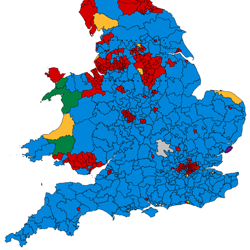
To see why, we use a way of measuring how biased the electoral system is in favour of one party rather than another, developed in the early 1960s by New Zealand political scientist Ralph Brookes. The basic idea is simple. If two parties get the same share of the vote, then – so long as the electoral system is not biased more in favour of one party than another – both should get the same number of MPs. But if one party gets more MPs for the same vote total than the other, the system is biased relatively in favour of the former – and the number of extra MPs gained gives an indicator of that bias.
Obviously, in actual elections, it is rare for two parties to obtain the same number of votes. But we can simulate that situation by taking two parties and replaying the election so that (if nothing else changes) they tie on national vote share. In 2015, for instance, it would take a 3.3% swing from Conservative to Labour to tie the two on 33.6%. Applying this swing uniformly to their votes in all seats allows us to estimate how many constituencies each would win if they had identical vote shares nationally.
If nothing else had changed in 2015 except that the Conservatives and Labour had tied in their vote totals, the former would have won 301 seats and the latter 254, a 47-seat bias in favour of the Conservatives. Mr Cameron would have been deprived of his overall majority, but would still have emerged as the leader of the largest party in the Commons.
This is a remarkable reversal of fortune, as we can see by applying the same approach to every general election since 1950. The first graph shows how many more seats one of the two would have won relative to the other at each election. Where the bias worked in Labour’s favour, the net bias is positive – where it worked for the Conservatives, it is negative.
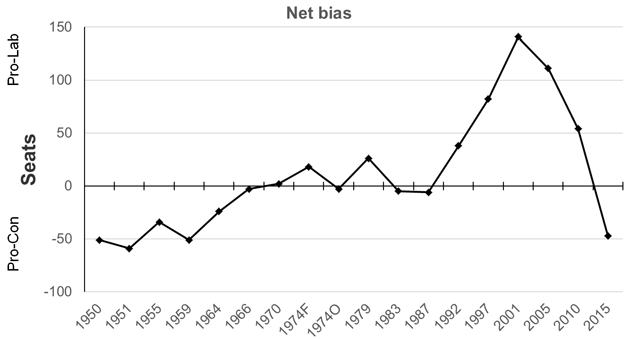
In the 1950s, net bias benefitted the Conservatives more than Labour. This was largely due to the rules surrounding redrawing constituencies, which then allowed rural seats (where the Conservatives tended to win) to have somewhat smaller electorates than urban seats. This rule was removed in the late 1950s, and from the early 1960s till the late 1980s there was no systematic bias between Labour and Conservative. But from the early 1990s on, the electoral system gave Labour an (often very substantial) advantage over the Conservatives.
Both parties are well aware of this recent pro-Labour bias. Labour hoped it would continue. The Conservatives were keen to remove it so when they returned to government in 2010, they therefore quickly introduced legislation changing how parliamentary constituency boundaries are drawn. The new legislation (enshrined in the 2011 Parliamentary Voting System and Constituencies Act) attempts to achieve this by mandating more frequent reviews of seats (before every quinquennial general election) and requiring that virtually every seat would have the same electorate (within ±5% of the national average). The new rules were enacted by the Boundary Commissions in their Sixth Periodic Review, but – as a result of internal disputes within the Coalition – the Review was not implemented in time for the 2015 general election, which was fought using the same constituencies as the 2010 contest. The Conservatives’ attempt to legislate the pro-Labour bias away did not come to fruition.
In the event, however, it didn’t need to! At the 2015 election, the problem of electoral bias as far as the Conservatives were concerned not only solved itself, but became a distinct advantage for the party. 2015 is the first election in over 50 years in which the bias in the electoral system has worked substantially more in the Conservatives’ favour than in Labour’s; indeed, it favoured them by as much as it did in the late 1950s.
To understand how the pro-Labour bias emerged, and how it has been replaced by a pro-Conservative one, we need to look at the underlying mechanics. At root, the issue is how many votes it takes to elect each MP. Other things being equal, the fewer the better, as this achieves a more efficient conversion of votes into MPs.
We can break this down into four effects.
The first set of effects is produced by variations in constituency size. If one party tends to do better in smaller constituencies, while the other tends to do best in larger ones, a bias will build up in favour of the former party, as fewer votes are needed to elect its MPs. There are two major sources of this bias. First, constituency electorates in Scotland and Wales tend to be smaller, on average, than in England (a result of legislation establishing minimum numbers of MPs for the former countries).
Second, the general drift of population from cities to suburbs and from the north to the south over time tends to mean that, the longer a particular set of constituencies is used, the greater the disparity between northern urban seats with declining electorates and southern, suburban ones with growing electorates. Periodic revisions of the constituency map to take into account these population changes help redress the balance, but over time these constituencies age too, and the disparities re-emerge.
Over time, as the next graph shows, both the national and the constituency size effects have tended to help Labour rather than the Conservatives, as the former has tended to do better in Scotland, Wales and the northern cities, while the latter has gained more votes in the south and the suburbs. The peaks and troughs in the constituency size effect reflect the periodic reviews to the constituency map.
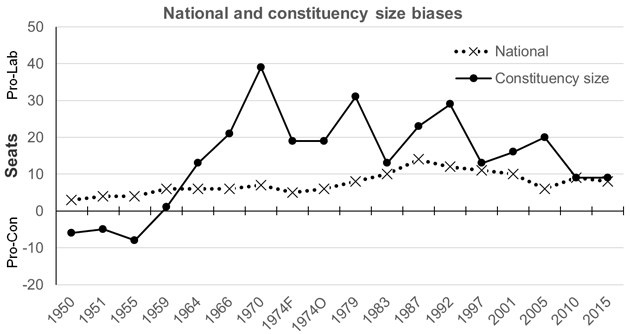
Both still worked in Labour’s favour relative to the Conservatives in 2015, but neither was a major source of bias then – together, they were worth 17 extra seats for Labour compared to the Conservatives. And – although the same constituency boundaries were in operation in 2015 as in 2010 (and in Scotland, they have been in use since 2005) – the constituency size effect did not grow between the two elections (in part due to changing patterns of population growth, particularly in regenerating city centres) and the parties’ (especially Labour’s) efforts to register more student voters in many university towns and cities – hoping to gain from their discontent with the party that pledged to remove university fees.
These were the sources of pro-Labour bias which the 2011 legislation was designed to remove (by equalising electorates for all constituencies). The failure to implement the Sixth Review leaves them largely intact.
But – despite being the focus of the 2011 legislation – variations in constituency size were not the main source of the post-1992 pro-Labour bias (nor, obviously, of the pro-Conservative bias in 2015). Other sources are more consequential – and much harder to deal with via legislation.
The second source, abstention, helps Labour get more MPs for its votes than the Conservatives. The reason: turnout tends to be lower in Labour than Conservative seats. Even if all seats had identical electorates, therefore, this means it takes fewer votes to elect a Labour than a Conservative MP. And (as the next graph illustrates) this has been especially true in recent elections, when turnout overall has been well below the post-war average and has declined especially in Labour-held seats (as in Liverpool).

In 2015, abstention was worth an extra 24 seats for Labour relative to the Conservatives. This was down somewhat on the previous three elections (when it had been worth almost 40 extra seats for the party), but was still substantial. Of course, abstentions fell in Scotland where turnout was relatively high in 2015 – and Labour lost all but one of its seats there in any case.
Neither constituency size nor abstention effects can explain the dramatic shift to a pro-Conservative bias in 2015, however. To explain this, we need to look elsewhere. Our next contributing factor is the dramatic change in how third parties affect the relative bias between Conservative and Labour.
The key issue here is where third parties tend to do well – and how well they do. If third parties tend to do better in seats where one of the big two parties does better than the other, this will affect the Conservative-Labour bias. If third parties do quite well in a seat, but not well enough to defeat the incumbent party, the latter gets an advantage, as this in effect reduces the number of votes needed to win there. But if a third party wins a seat, this creates a bias against the major party which would otherwise expect to take the seat, as all its votes there are wasted.
Bearing that in mind, third party effects over most of the post-war period (shown in the next graph) have been fairly consistent. Third party votes (short of winning a constituency) have tended to produce pro-Conservative biases, while third party wins have tended to help Labour. The reason is simple: for much of the period, the main third party in British politics has been the Liberal Democrats (and their predecessors). On the whole, Liberal Democrat candidates have tended to do best in areas where the Conservatives are more successful than Labour. And so the more votes the Lib Dems gained (short of winning), the bigger the bias in favour of the Conservatives. But when the Lib Dems began to win seats, they took more from the Conservatives than from Labour – so Lib Dem wins contributed to the growing pro-Labour bias.
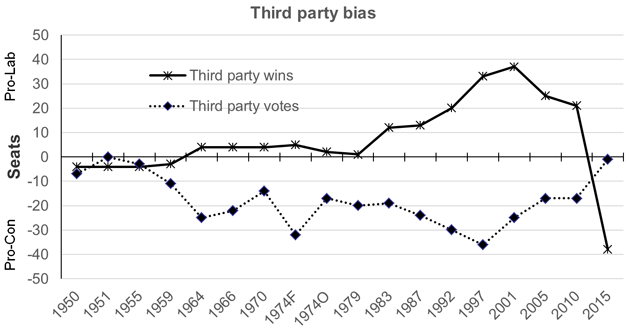
Not so in 2015, however. Third party wins – for the first time in fifty years – now work substantially to the Conservatives’ advantage (to the tune of an extra 38 seats over Labour). Third party votes, meanwhile, are now almost neutral in their effect (just a 1 seat pro-Conservative advantage). The reason is obvious: the 2015 election radically redrew the third party map in the UK. The Lib Dems collapsed, in both vote share and seats. The third party ‘gainers’ in 2015 were UKIP and the SNP, the former in terms of votes, and the latter in terms of seats too.
The SNP, with 56 MPs, is now the third largest party in the new House of Commons. And most of its new MPs were elected in constituencies that previously returned Labour members. Hence (combined with the Conservatives’ success in taking many seats from the Lib Dems) the ‘third party wins’ effect now substantially punishes Labour and helps the Conservatives.
As for UKIP, while it only won one seat, it gained a substantial number of votes. And it did so relatively evenly in Conservative and Labour held seats. In each, the average UKIP vote share in 2015 was just over 14%. This, combined with the fall in Lib Dem support, helps explain why the ‘third party votes’ effect is now almost neutral between Conservative and Labour.
Our final source of bias is how efficiently a party’s votes are spread. Under first past the post this is very important, as gigantic majorities and near-miss defeats waste lots of votes. Once a candidate gains one more vote than her nearest rival, she has won the constituency. Every extra vote for her is in effect wasted (or surplus to requirements!), as it elects no further MPs. Similarly, losing narrowly is inefficient (at least in the short term), as those wasted votes also fail to elect MPs for the party. The closer parties can get to an efficient vote spread (with as many seats won by relatively narrow margins as possible), the better in terms of the conversion of votes into seats (though not necessarily in terms of MPs’ comfort zones).
In recent years, parties have tried to achieve this by targeting their constituency campaigns relentlessly on the marginals, to the neglect of both safe and ‘no hope’ seats. Labour in particular learned to do this very effectively in the 1990s and early 2000s, aided by tactical anti-Tory voting there, while the Conservatives did not (the latter still ran strong campaigns in safe seats, amassing large – but useless – majorities). As the next graph shows, this ‘efficiency bias’ was by far the largest source of the major pro-Labour biases in the 1997, 2001 and 2005 elections.
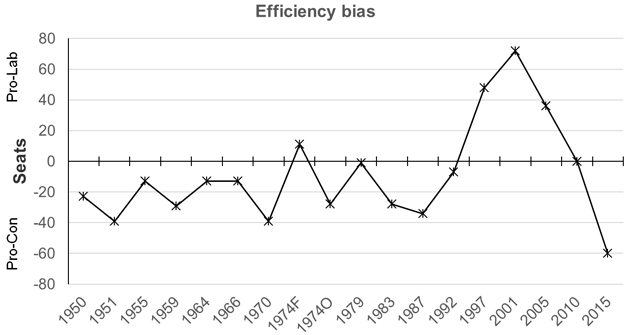
But it had already evaporated in 2010 (when the Conservatives mounted a far more effective target seat strategy than in previous elections). And this year, it worked substantially in the Conservatives’ favour – worth a whopping 60 seats over Labour. Indeed, the relative efficiency of their vote spread was the single largest contributor to the overall pro-Conservative bias. This may be down in part to the Conservatives’ continued ‘ground war’ focus on marginal seats. In part, too, (a result of the Conservatives’ gains and Labour’s losses), the former held somewhat more seats by smallish margins than the former in 2015, and lost fewer narrowly. The Conservatives took 57 seats with margins of less than 10%, compared to 49 for Labour: but the numbers each lost by 10% or less were 47 and 48 respectively.
Going into the 2015 election, the Conservatives were fearful that – as in most recent elections – electoral bias might cost them dearly. By the same token, Labour were hopeful that it would help them (and, with a close result anticipated, might just help see Ed Miliband into Number 10). Both views were bolstered by the failure to implement the Sixth Periodic Review of the UK’s constituencies.
In the event, that failure was not the key event many thought. Bias was not abolished (in truth, the 2011 Act was very unlikely to achieve this, as it tackled only one – relatively minor – source of that bias). But it did change dramatically. And it changed for political, not demographic, reasons.
The challenge facing Labour in 2020 was already difficult. It needs to win almost 100 seats, a tough challenge made even harder by the difficulty of rebuilding its former Scottish base. But, with the electoral system now working substantially against it and in favour of its major rival, things just got even harder – and the review of constituency boundaries due to start in 2016, with a new set of 600 seats (or 650 if the government amends the legislation) in place by 2020 could exacerbate the problem. Mr Cameron has more reasons than one to smile.
This article was first published on the Sir Bernard Crick Centre's blog.




